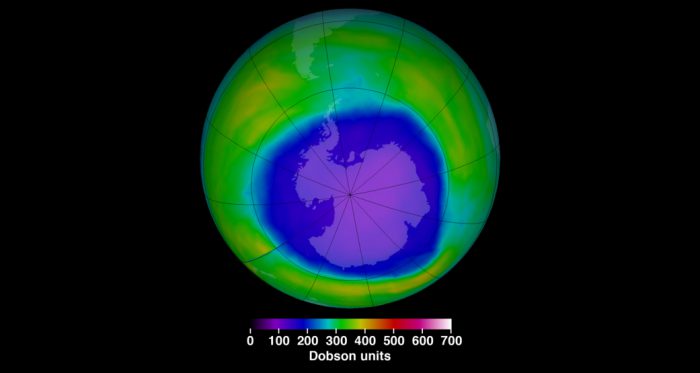A recent study by NASA has confirmed that the ozone hole over Antarctica is getting smaller. There is 20% less depletion there now than there was in 2005. This improvement is thanks to us not using man-made chemicals called chloroflourocarbons (CFCs).
CFCs contained chlorine that, when released into the upper atmosphere, attacked ozone molecules. Because the ozone layer is what shields us from a majority of the Sun's ultraviolet radiation, or UV rays, this was a big problem.
That is why back in 1987, an agreement called the Montreal Protocol was signed to phase out and eventually ban the use of CFCs. The agreement included 197 countries, essentially every nation on Earth. Three decades later, that global teamwork is paying off. Which is impressive, because CFCs used to be everywhere.
The history of CFCs
CFCs were used regularly for about two centuries to perform a couple tasks. They were used as refrigerant — a fluid to keep your family's fridge nice and cool, for example. And they were used as a propellent. If you had something that you want to shoot out of a can — like paint or hairspray — a CFC was the perfect stuff for the job. Except for one problem.
CFC molecules in the atmosphere were broken down by the Sun's UV rays. Newly-released chlorine atoms then attacked ozone molecules, destroying them. Over time, this created a hole in the ozone layer.
CFCs were replaced in aerosol cans by HCFCs (hydrochlorofluorocarbons) and HFCs (hydrofluorocarbons). Though these substances still contribute to ozone depletion, they are far less harmful. Scientists are working on even better replacements that are completely safe for the environment. (Getty Embed)
In the 1970s, scientists began really sounding a warning that an ozone hole over Antarctica was growing. And that CFCs were to blame. Though it took some time to agree on, the Montreal Protocol led to massive changes. The use of CFCs were regulated, then banned completely nearly everywhere.
Now as the chlorine in the atmosphere very slowly disappears, the ozone is healing itself.
Slow, but steady progress
Members of the Montreal Protocol still meet regularly to improve and update their regulations. (Getty Embed)
When the task is healing the planet, there's no such thing as a quick fix or a half-hearted effort. Rebuilding the ozone is still a big job and it has taken literally everyone in the world doing their part to achieve what we have so far. For treaties such as the Paris Agreement to have the same success, the same group effort will be needed.
But we can take really take heart that nothing is beyond our grasp when we apply ourselves as a group. Whether it's addressing pollution, green energy, or climate change, these treaties make a difference. That's inspiring stuff!
If you want even more specifics about how the ozone is improving, NASA has got your back in the video below.
 Though the hole in the ozone is still larger than we'd like, it is healing itself thanks to bans and regulations on CFCs. (NASA's Goddard Space Flight Center)
Though the hole in the ozone is still larger than we'd like, it is healing itself thanks to bans and regulations on CFCs. (NASA's Goddard Space Flight Center)









